

Geographies
of the Eikaiwa Wonderland
Outline of the
Eikaiwa Wonderland Project
Eikaiwa is a Japanese term that can be translated as “the activity
of English conversation.” It is often used metonymically to mean an organization
that teaches conversational English, particularly one of the big private English
conversation schools. In Japan there are many hundreds of eikaiwa
establishments. The largest companies are NOVA Intercultural Institute, GEOS,
AEON and ECC (the Big Four). Each of these organizations has an extensive
network of schools located throughout Japan and a network of recruitment offices
abroad. The corporate history of AEON serves as a typical example of the historical
growth of one of the bigger English schools. Founded in 1973, it had 25 branches
in 1984. By 1989 this had increased to 149, and by 1997 there were 230. At
that point, AEON employed over 2000 personnel, of whom about 500 were foreigners
(AEON 1997). The other big schools exhibit similar patterns of expansion over
this period (NOVA 2004, ECC 2004). Total estimates for eikaiwa sector
size are unreliable; however, according to some sources between 400,000 and
700,000 students are attending eikaiwa at any one time.
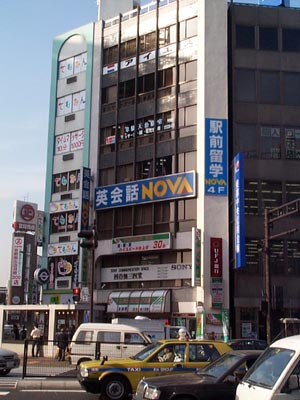
Figure 1: A typical NOVA branch in metropolitan Tokyo: "eigo gaigo"
[English conversation] and "ekimae ryugaku" [study abroad
in front of the station].
The goals of this project were to investigate the character of gendered participation
in private English conversation schools (eikaiwa) and to identify
a set of historically-rooted social, cultural and economic factors that contribute
to this situation. Between 1997 and 1998 and again in 2002 I conducted a detailed
ethnography of eikaiwa by means of participant observation, surveys
and interviews with students, staff and current and former instructors. I
also performed a semiological analysis of eikaiwa promotions.
Marketing the Eikaiwa Wonderland
The complex properties of the eikaiwa wonderland are constituted
by an interaction between larger social modalities, such as the labor market
and associated economic geographies of internationalization that condition
the gendered participation, and the daily practices and rituals that take
place within the physical spaces of eikaiwa. I have argued that the
marketing strategies and visual promotions of a range of eikaiwa
rely on inculcating and actualizing akogare (desire) by engaging
with a heterodoxical yet highly heteronormative array of gender stratifying
and rectifying ideologies. Key to these strategies are couplings between Japan
and the other, represented and embodied by professional/romantic/sexual pairings
between western eikaiwa instructors and female Japanese students.
References
Forthcoming. "Marketing the Eikaiwa Wonderland: ideology, akogare
and gender alterities in English Conversation School advertising in Japan."
Forthcoming in Environment and Planning D: Society and Space.
2003. Presentation at the Annual Meeting of the Association of American Geographers
Marketing
the Eikaiwa Wonderland
2002. "Living in the Eikaiwa Wonderland: English Language Learning,
Socioeconomic Transformation and Gender Alterities in Modern Japan."
Ph.D. Dissertation, University of Kentucky, Lexington.
Some examples of eikaiwa promotions are shown below.
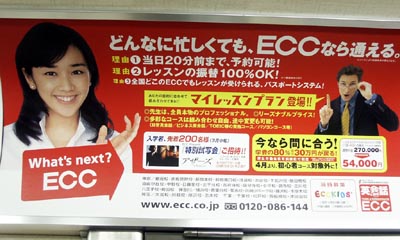
Figure 2: ECC Promotion,
spring 2002 (featuring Hikaru Nishida)
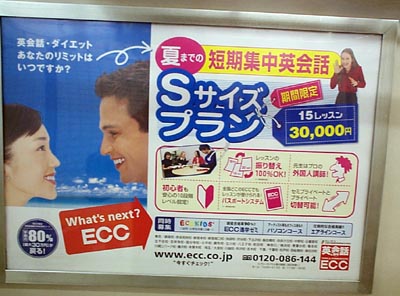
Figure 3: ECC Promotion,
summer 2002 (featuring Hikaru Nishida)
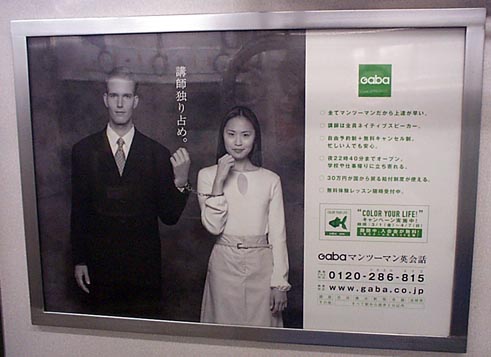
Figure 4: GABA promotion,
summer 2002
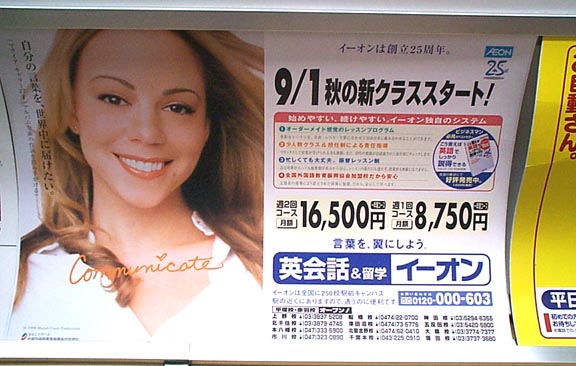
Figure 5: AEON Promotion,
summer 1998 (Mariah Carey)
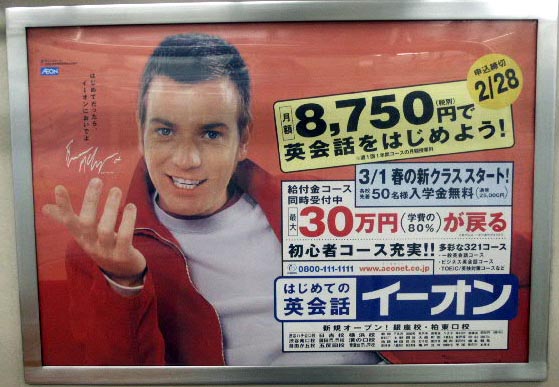
Figure 6: AEON promotion,
summer 2002 (Ewan McGregor)
This project is part of my research program dealing with economic
geographies of internationalization in Asia and the Pacific Rim.
If you have corrections, comments, or questions about this
web site, send Email to the WebArchitect
Copyright © 2004 Keiron Bailey